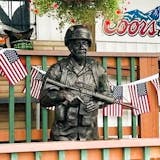For more than 50 years, a prime downtown Minneapolis block, lying at the intersection of three major avenues (Hennepin, Washington and Nicollet) has been a blight on the cityscape.
Starting in 1858, the Nicollet Hotel, in various forms, occupied the block. By the early 1970s, the once-elegant landmark had turned ghostly and derelict, posing for a time as a charity hotel before falling to the wrecking ball in 1991. But redevelopment never came. Even as new buildings rose all around it, the block remained a shabby surface parking lot for nearly three decades.
But not for much longer, perhaps.
If the City Council follows the lead of its zoning and planning committee and overrides technical objections from the city staff, as it should, then a glassy 37-story tower will rise on this grim block. Included in the design: retail and office space to house RBC Wealth Management's national headquarters, a premium hotel (Four Seasons), 22 luxury condominiums, a large underground parking garage, a leafy public plaza, a skyway connection to the city core and an easement for a future streetcar line.
Altogether, the Gateway tower would provide 1,300 construction jobs over a 30-month span, bring 3,500 daily occupants to the site, pay $9 million a year in property taxes and $6 million annually in sales, use and lodging taxes, and provide the city with $10.4 million for the land. Moreover, the tower and plaza would serve as the central pivot point between the downtown core and the lively North Loop and riverfront districts that line both banks of the Mississippi.
Add up those benefits, and they far outweigh the relatively minor objections posed by the city staff. True, the hotel's porte cochere on Hennepin Avenue would conflict with pedestrian and bicycle traffic. But the alternative — forcing cars to line up on the street to pick up and drop off hotel visitors — would clog auto traffic and pose bigger problems. In any case, these covered driveways are standard features at other major hotels and residential buildings downtown. The porte cochere, along with its covered valet ramp, should be approved.
As for RBC's proposed sign near the top of the building, yes, it would perch some 430 feet higher than the 50 feet suggested by city code. But a number of other buildings, most recently Wells Fargo's East Town towers, have been granted exceptions. The RBC sign would be modest in size, embedded in the structure, and face only south. The spirit of the sign ordinance is to prevent gaudy, flashy commercial sales pitches from dominating the skyline. There's no danger that this sedate sign would transform Minneapolis into Las Vegas.
United Properties, the project's developer, says that the porte cochere and the sign are essential elements, insisting that the tower "cannot move forward without a successful appeal." Although the City Council should not bow to every wish of the business community, it should pick its battles carefully. This shouldn't be one of them. The last time the council played games with an attractive corporate project, it lost a soccer stadium and a chance to redevelop its West Loop farmers market.



